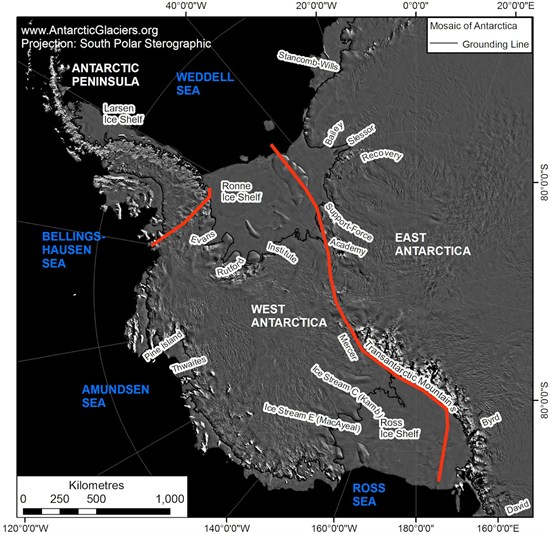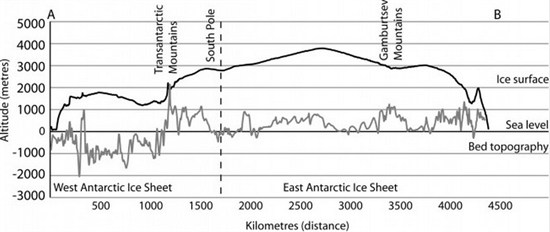Roz Pidcock
14.05.2014 | 10:00amCollapse, irreversible, unstoppable, catastrophic: Eye-catching words like these pepper recent media coverage of two scientific papers charting the demise of West Antarctic glaciers.
Both papers come to much the same conclusion – the region’s glaciers are shrinking under the pressure of rising temperatures and will ultimately add several metres to sea levels worldwide.
The research prompted some dramatic headlines. The Daily Mail’s headline reads ‘Nasa data reveals Antarctic ice sheet is melting at an ‘unstoppable’ speed’ while The Guardian says, ‘West Antarctic ice sheet collapse has begun already’.
Are glaciers retreating or collapsing entirely? When does retreat become a collapse? Do scientists think we’re heading for a collapse too? We’ve tried to answer some questions the coverage raises.
What’s the West Antarctic ice sheet? Why is it important?

Map showing West Antarctica and the location of the two biggest glaciers, Thwaites and Pine Island. Source: AntarcticGlaciers.org
The West Antarctic Ice Sheet (WAIS) is one of three regions making up Antarctica. The other two are East Antarctica and the Antarctic Peninsula, with the Transantarctic Mountain range dividing East from West. The two major glaciers in West Antarctica – Pine Island Glacier and Thwaites Glacier – flow into the Amundsen Sea, carrying ice from the mountains to the ocean.
Scientists have long thought the WAIS to be the most vulnerable part of Antarctica to rising temperatures. It’s what’s called a marine based ice sheet, which means a lot of it sits on land that is below sea level.
Changes in wind and ocean circulations are bringing warm water in contact with the Amundsen shelf and vast warm pools are forming under the ice sheet, melting it from the bottom up.

Unlike the East Antarctic ice sheet, a lot of the West Antarctic ice sheet is below sea level, making it vulnerable to bottom-up melting by warm water. Source: AntarcticGlaciers.org
As the front edge of the ice sheet retracts inwards, it meets with deeper water, because of the bowl shape of the WAIS basin. This steepens the ice face, making it unstable and causing ice to slide more quickly into the ocean. This point marks a critical threshold, beyond which ice melt accelerates over time until the glacier has disappeared completely.
The Antarctic Glaciers website by ice sheet expert at Aberystwyth University Bethan Davies features a good explanation of the ice sheet’s instability.
Is it the Amundsen glaciers that are at risk, or the whole ice sheet, or both?
At the moment, it’s the glaciers along the Amundsen coast that are losing ice. Scientists have done extensive satellite, air and ground surveys and found not only are the glaciers shrinking but there’s nothing stopping the ice from melting away completely, like a ridge or other obstacle.
That’s what scientists mean when they talk about the glaciers’ “collapse” – the chain of events leading to their disappearance looks to be already underway.
Here’s NASA glaciologist and lead author on one of the new papers, Eric Rignot, explaining the processes leading to the decline of six Amundsen glaciers in West Antarctica.
This isn’t the same as saying the whole WAIS is doomed to disappear – but it is all connected, Hamish Pritchard from the British Antarctic Survey (BAS) tells us. As these glaciers lose ice and thin out, they can draw down ice from neighbouring glaciers.
The destabilising effect is amplified by the melting of ice shelves at the edge of the ice sheet, which help keep the interior of the ice sheet stable – an effect known as “buttressing”. Losing them helps unlock the rest of the WAIS to faster ice loss.
On their own, the six main Amundsen glaciers could add about 1.2 metres to global sea level, scientists say. But they are most concerned about what’s likely to happen to the WAIS without these huge glaciers to prop it up.
What does it mean if the WAIS collapses? Will it lose all of its ice, or just most of it?
Scientists generally don’t think the WAIS will end up losing absolutely all its ice, Pritchard explains.
“Ultimately, it’s likely to mean most rather than all [the ice] because even with a whole-ice-sheet collapse, we’d expect some sizeable remnants to persist around the mountain ranges.”
Even so, scientists estimate the West Antarctic contribution to sea level would still about 3.3 metres. That’s on top of the sea level rise coming from Greenland ice sheet, glaciers and other ice caps on land, as well as sea level rise caused by seawater expanding as it warms up.
Do scientists think the collapse of the WAIS glaciers is “unstoppable”?
If the ice streams are truly inherently unstable and if they have been forced beyond a critical threshold, then the collapse is unstoppable, explains Pritchard. The question is have we passed the critical point? The new research would suggest we have, he says:
“There’s no doubt that [the glaciers] are being forced (by the ocean) to retreat and both of these papers say that they do think that this unstable, unstoppable retreat has begun. They both have some caveats though â?¦ Both studies fall frustratingly just short of being definitive.”
For example, scientists can’t be absolutely sure the critical threshold has been crossed for the Thwaites Glacier, Pritchard explains. The authors consider a range of scenarios and it’s reached in all “except in the lowest-melt scenario” – which observations suggest is far too optimistic.
We asked author on that paper, Ian Joughin from the University of Washington, the same question. He told us:
“Definitively unstoppable no; likely unstoppable yes. There is always some uncertainty as our model like any model has to make some assumptions.”
Does “unstoppable” mean the same as “irreversible”?
Effectively yes. Rignot described the Amundsen glaciers to a NASA press conference as having “passed the point of no return.” In other words, scientists see no scenario in which collapse of the glaciers could now be avoided. Pritchard explains:
“An unstable (/unstoppable/irreversible) retreat in this context means that once the threshold is crossed, the retreat will occur regardless of what happens to the forcing”.
Ice loss will continue until a new ‘steady state’ is reached where ice loss equals ice gained through snowfall, Pritchard adds. But this steady state would not be reached until much of the ice was gone and the remnants had retreated onto higher ground, he adds.
None of this will happen quickly. The scientists put a timeline anywhere between 200 to 1000 years, depending on how quickly the water warms. Observations would suggest it’s more likely to be the lower end of that range, scientists say.
The New York Times quotes from NASA’s Thomas P. Wagner, who was involved in the research, as saying:
“This is really happening. There’s nothing to stop it now. But you are still limited by the physics of how fast the ice can flow.”
Could the changes in West Antarctica be described as “catastrophic”?
Though scientists don’t tend to use those words lightly, the consequences could well be described this way. Pritchard explains:
“Collapse of the WAIS would (ultimately) redraw every coastline, drive retreat of coastal cities and farmland as damaging storm surges became more frequent, would change the Earth’s appearance (and albedo) from space and would considerably alter regional and global ocean circulation with probably important consequences for global weather patterns. On the centuries timescale, it’s probably fair to call it catastrophic.”
It depends how you define catastrophic, Joughin tells us:
“[N]obody is going to wake up with water all of a sudden in their living room … [but] … Over decades to centuries though, populations will be displaced and billions of dollars of infrastructure lost.”
Do any these findings affect East Antarctic or the Antarctic Peninsula?
Melting glaciers in West Antarctica shouldn’t directly affect the Antarctic Peninsula or East Antarctica, because of the separation of the Transantarctic Mountains. However, there is some separate evidence of smaller-scale retreat on some glaciers in East Antarctica. Scientists warn glaciers are vulnerable if ocean warming causes ice melt as it has in the WAIS.

